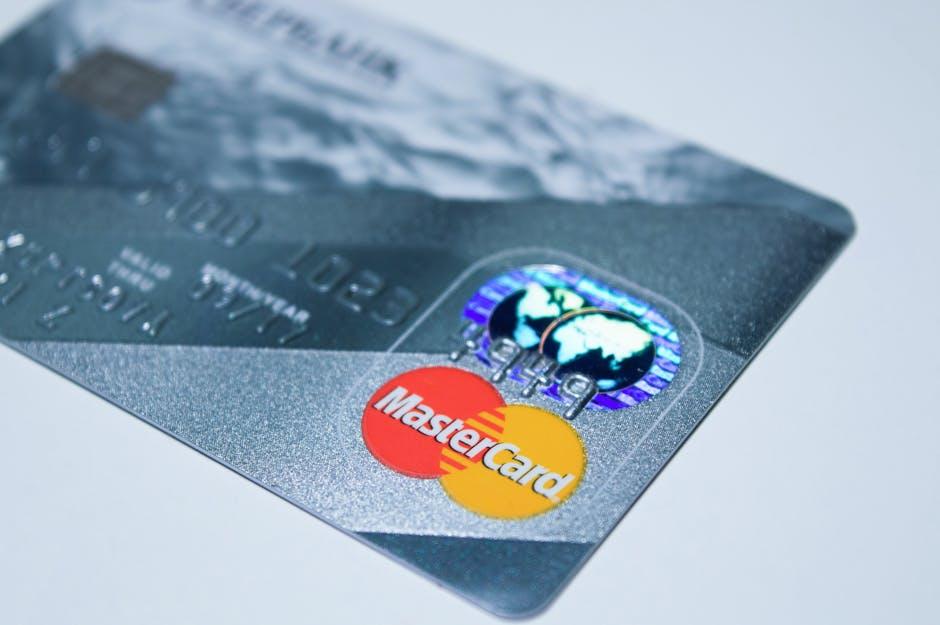In today’s fast-paced financial landscape, mastering multiple credit cards can be a strategic move that leads to enhanced savings, rewards, and improved financial management. While acquiring several cards might seem daunting, it opens up a world of possibilities for savvy spenders. Each card offers unique benefits, from cashback on groceries to travel points and even varying interest rates. By understanding how to effectively navigate the intricacies of credit card usage, individuals can make informed choices that not only bolster their credit scores but also maximize their purchasing power. This article delves into the art of juggling multiple credit cards, offering practical tips and insights to help you harness their potential for smarter financial decisions.
Navigating the Landscape of Credit Card Options
can feel overwhelming, but understanding the different types available and how they align with your financial goals can help simplify the decision-making process. Here’s a breakdown of key credit card categories that can aid in your smart financial choices:
- Balance Transfer Cards: If you’re carrying high-interest credit card debt, these cards can significantly reduce your interest payments. They often offer low or even 0% introductory APR for a set period, allowing you to pay down your balance faster.
- Cash Back Cards: Ideal for everyday spending, cash back cards reward you with a percentage of your purchases back. Look for higher percentages in categories that match your spending habits, such as groceries or gas, to maximize rewards.
- Rewards Cards: These cards offer points or miles for every purchase, which can be redeemed for travel, merchandise, or other benefits. They are best suited for those who pay their balance in full each month to avoid interest charges.
- Secured Credit Cards: Excellent for individuals looking to build or rebuild their credit history, these cards require a cash deposit as collateral. They work like regular credit cards and can help improve your credit score over time if managed responsibly.
- Student Credit Cards: Designed for young adults and students with limited credit history, these cards often feature lower credit limits and may come with rewards or cash back opportunities tailored towards students’ spending habits.
Understanding Key Features
| Card Type | Best For | Key Benefits |
|---|---|---|
| Balance Transfer | Reducing Debt | Low or 0% APR for transfers, consolidation of debt |
| Cash Back | Everyday Expenses | Percentage back on purchases, bonus categories |
| Rewards | Travel Enthusiasts | Points or miles for travel, sign-up bonuses |
| Secured | Credit Building | Credit score improvement, manageable risks |
| Student | Young Adults | Building credit, student-friendly rewards |
When selecting a credit card, consider your lifestyle and spending habits. Examine the interest rates, annual fees, and reward structures. Make informed comparisons and choose cards that align with your financial strategies to enhance your credit health and redeem valuable perks.
Remember, keeping track of your credit utilization and paying off your balance in full each month is crucial in maintaining a good credit score. Utilize tools and apps that help you monitor your spending and credit score to stay on top of your financial commitments.

Unlocking Benefits: Maximizing Rewards and Cashback
Maximizing rewards and cashback from your credit cards hinges on smart choices and strategies. Here are key points to consider that can help you tap into the potential benefits of your credit cards:
- Choose the Right Cards: Select cards based on your spending habits. If you dine out often, a card offering higher cashback or points for restaurants will be beneficial. Consider cards like the Chase Freedom Flex for its versatile cashback categories that rotate quarterly.
- Utilize Sign-Up Bonuses: Many cards offer generous sign-up bonuses for meeting specific spending thresholds in the first few months. For instance, the Capital One Venture Rewards Credit Card offers significant bonus miles on qualifying purchases.
- Daily Payment Strategy: Use your credit cards for everyday purchases such as groceries, gas, and utility bills. This maximizes points accrual without adding unnecessary debt. Many cards reward common spending categories handsomely.
- Pay Your Balance in Full: Avoid interest charges by paying your balance in full each month. Interest rates can negate the benefits of rewards. Some cards also offer introductory 0% APR promotions, making it easier to manage payments early on.
- Keep Track of Rewards Expiration: Be aware of any expiration dates on points or cashback. Some programs reset or expire after a certain period, and you don’t want to lose hard-earned rewards.
Consider the following comparison of a few top rewards credit cards:
| Credit Card | Rewards Type | Annual Fee | Sign-Up Bonus | Cashback Rate |
|---|---|---|---|---|
| Chase Freedom Unlimited | Cashback | $0 | $200 After Spending $500 in the First 3 Months | 1.5% on All Purchases |
| Capital One Quicksilver | Cashback | $0 | $200 After Spending $500 in the First 3 Months | 1.5% on All Purchases |
| Amazon Prime Rewards Visa | Points | $0 (With Prime Membership) | $150 Gift Card Offer | 5% at Amazon.com |
By leveraging these strategies and selecting the right cards tailored to your lifestyle, you can truly unlock the benefits of rewards and cashback. Keeping track of your expenses will not only enhance your financial health but also turn everyday spending into rewarding opportunities.

Understanding the Fine Print: Fees, Rates, and Terms
When navigating the world of credit cards, understanding the fine print is crucial to making informed financial decisions. Each credit card comes with its own set of fees, rates, and terms that can significantly impact your overall financial health. Here are some essential elements to consider:
- Annual Percentage Rate (APR): This is the cost of borrowing expressed as a yearly interest rate. Not all cards have the same APR, so comparing them can save you money, especially if you carry a balance.
- Cardholder Agreement: This legal document outlines your rights and responsibilities as a cardholder. It details important terms, including how interest is calculated, applicable fees, and your liability for unauthorized transactions [[1]](https://www.consumerfinance.gov/consumer-tools/credit-cards/answers/key-terms/).
- Fees to Watch For: Many credit cards have various fees that can catch you off guard. Familiarize yourself with the common ones:
- Annual Fee: Some cards charge a yearly fee to maintain your account. Weigh this fee against the benefits the card offers.
- Late Payment Fee: Failing to pay your bill on time can lead to hefty charges. Set reminders to avoid this.
- Foreign Transaction Fee: If you travel internationally, be aware some cards charge a fee for purchases made in foreign currencies.
- Cash Advance Fee: Withdrawing cash using your credit card often incurs high fees and interest rates from day one.
To help you visualize some of these elements, here’s a simple comparison of typical fees across different card types:
| Card Type | Annual Fee | APR Range | Foreign Transaction Fee |
|---|---|---|---|
| Standard Rewards Card | $0 – $95 | 15% – 25% | 1% – 3% |
| Cash Back Card | $0 – $50 | 14% – 24% | 0% – 3% |
| Travel Rewards Card | $0 – $550 | 16% – 20% | 0% – 3% |
Remember, always read the cardholder agreement before applying for a card. Knowing the terms will prevent surprises and empower you to make smart financial choices. With multiple cards, strategy is key: leverage rewards while keeping an eye on fees and your overall credit utilization to maintain a healthy credit score.

Crafting a Strategic Approach to Credit Management
Managing multiple credit cards effectively can be a game-changer for your financial health. involves recognizing how to leverage your cards, understand the associated benefits, and maintain a healthy credit score. Here are some essential strategies to consider:
- Track Spending Across Cards: Use tools like budgeting apps or spreadsheets to monitor spending. This helps prevent overspending and ensures you maximize rewards and benefits associated with each card.
- Understand Your Credit Utilization: Aim to keep your credit utilization ratio below 30%. This means if your total credit limit is $10,000, you should keep your balances below $3,000. Lower utilization can positively impact your credit score.
- Pay More Than the Minimum: Try to pay your balance in full each month to avoid interest charges. If that’s not possible, pay more than the minimum payment to reduce the overall interest paid and improve your credit score.
- Use Alerts and Notifications: Set up alerts for due dates and spending thresholds. This ensures you never miss a payment and helps you stay on top of your spending habits.
- Choose Cards with Benefits That Fit Your Lifestyle: Whether it’s cash back, travel rewards, or points, select cards that align with your spending habits. For instance, if you travel frequently, a card with travel perks can be invaluable.
| Card Type | Key Benefit | Potential Drawback |
|---|---|---|
| Cash Back | Earn a percentage back on purchases | Some may have annual fees |
| Travel Rewards | Points towards free flights and hotels | High-interest rates if not paid off |
| Low-Interest | Minimized interest payments for balances | Limited rewards programs |
Additionally, regularly check your credit reports from all three major credit bureaus-Experian, TransUnion, and Equifax-at least once a year. This practice allows you to spot errors and address them promptly, safeguarding your credit score.
By adhering to these strategies, you can master the art of managing multiple credit cards. It’s not just about having various cards; it’s about using them wisely to enhance your financial well-being.

In Conclusion
As we wrap up our journey into the art of mastering multiple credit cards for smart financial choices, it becomes clear that balance is key. Embracing the benefits of different cards-whether it be cashback rewards, travel perks, or low-interest rates-can significantly enhance your financial landscape. However, it’s crucial to wield this power with responsibility. By monitoring your spending, paying off balances in full, and understanding the terms of each card, you can create a diverse financial toolkit that not only meets your needs but also strengthens your financial future. Remember, the goal isn’t just to collect cards; it’s to cultivate a strategy that propels you towards your financial aspirations. So, go forth with confidence, and let your credit card mastery pave the way for smarter financial decisions ahead.














